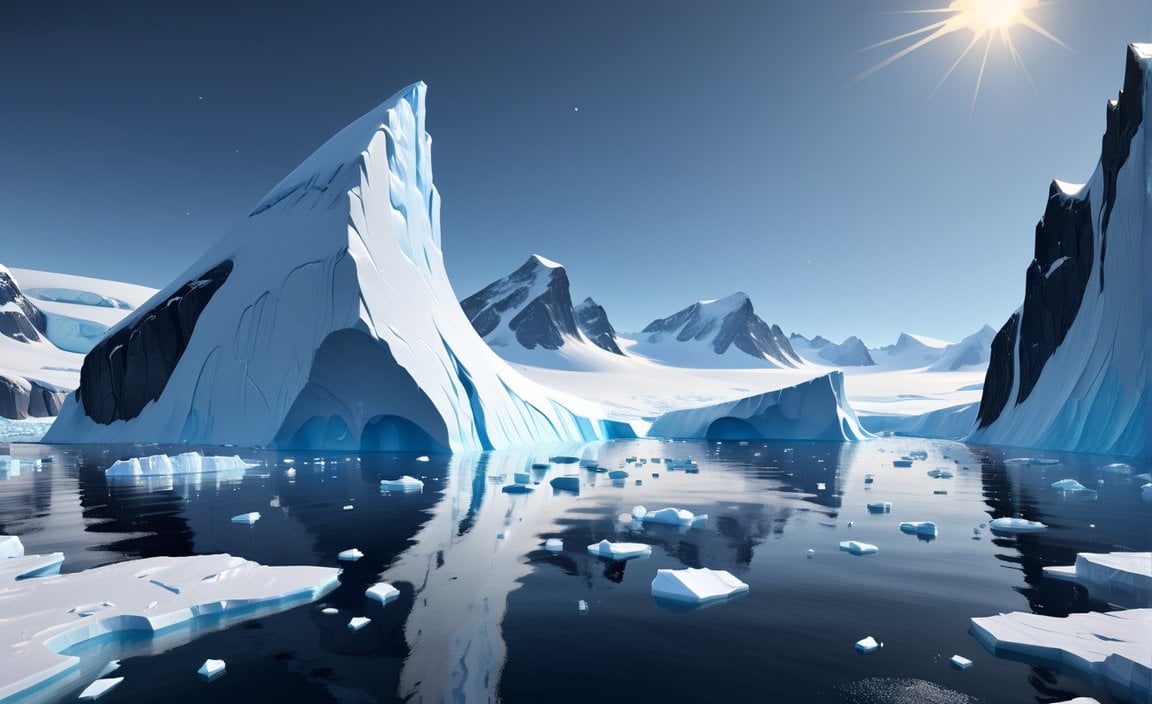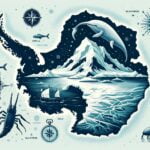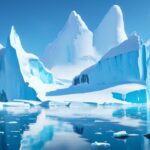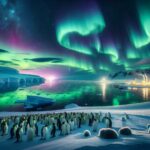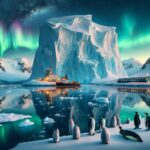Get ready to embark on a journey to the southernmost continent, Antarctica, as we unveil 10 fascinating facts about this frozen continent. From its unparalleled landscapes to its remarkable wildlife and groundbreaking climate research, Antarctica holds a wealth of wonders waiting to be discovered. Join us as we delve into the intriguing secrets of this icy realm and shed light on the enigmatic world that lies beyond the icy veil. Get ready to be captivated by Antarctica’s breathtaking beauty and learn about the critical role it plays in our planet’s ecosystem.
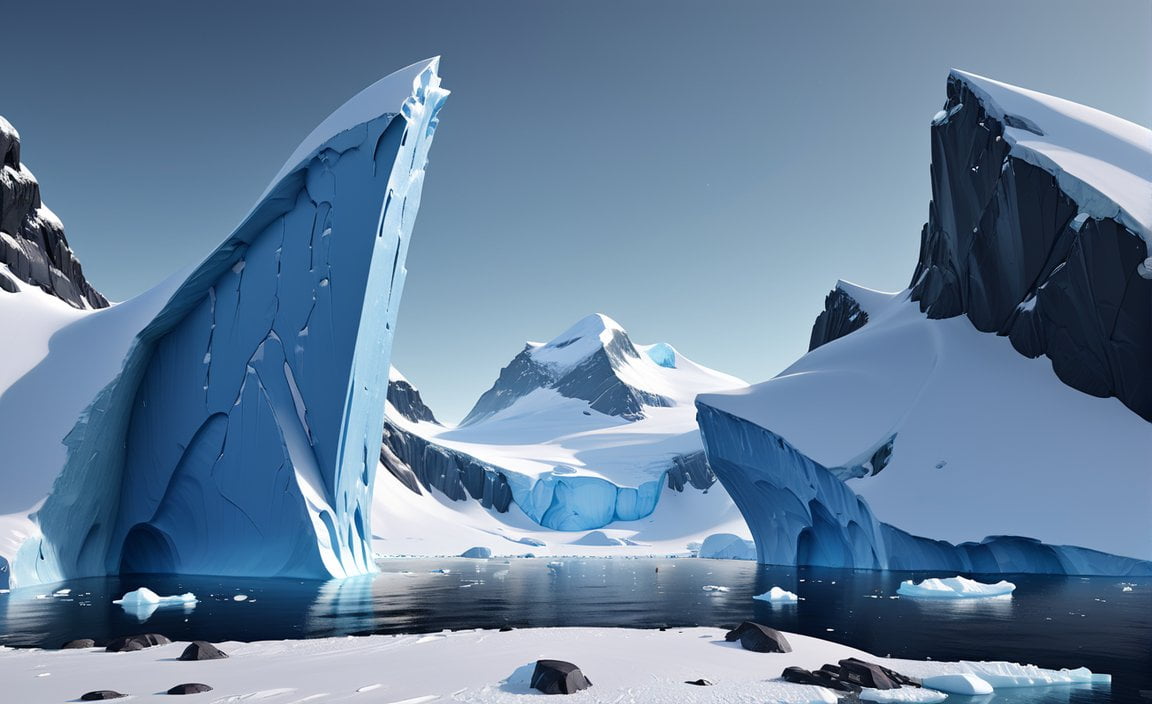
Key Takeaways:
- Coldest Continent: Antarctica is the coldest continent on Earth, with the lowest recorded temperature reaching -89.2 degrees Celsius.
- Extreme Conditions: Antarctica is the driest, highest, and windiest continent, with winds that can reach over 200 mph.
- Largest Desert: Despite its icy appearance, Antarctica is actually the largest desert in the world, covering 14 million square kilometers.
- Enormous Size: Antarctica is 1.3 times larger than Europe, making it one of the largest landmasses on Earth.
- No Permanent Residents: Antarctica has no permanent residents or native population, making it a truly uninhabited continent.
- Preparations for Antarctic Work: Some individuals planning to work in Antarctica are required to have their wisdom teeth and appendix removed due to limited medical facilities.
- Historic Exploration: Explorers reached the South Pole for the first time in 1911, marking a significant milestone in Antarctic exploration.
- No Official Time Zone: Unlike other regions, Antarctica does not have an official time zone, which can create unique challenges.
- Ice and Freshwater Deposits: Antarctica is home to about 90% of the world’s ice and holds approximately 70% of the world’s freshwater reserves.
- Active Volcano: Antarctica has an active volcano known as Mount Erebus, which is known for spewing crystals and adds to the continent’s geologic diversity.
10 Facts About Antarctica
Antarctica, the frozen continent located at the bottom of the Earth, is a captivating and mysterious place. With its extreme weather, unique wildlife, and vast icy landscapes, it offers a glimpse into a world untouched by human civilization. In this article, we will unveil ten fascinating facts about Antarctica that highlight its remarkable characteristics and ongoing scientific research.
1. Antarctica: The Coldest Place on Earth
At the forefront of incredible Antarctic facts lies its chilling title as the coldest continent on Earth. With temperatures plunging to a bone-chilling -89.2 degrees Celsius, Antarctica holds the record for the lowest temperature ever recorded. It’s a land where the air bites your skin and freezes your breath.
2. The Driest, Highest, and Windiest Continent
Antarctica takes the crown in three extreme categories. Besides being the coldest, it is also the driest continent on our planet. Imagine vast areas with little to no precipitation, leaving the landscapes barren and desolate. Additionally, Antarctica boasts the highest average elevation, with an average height of more than 8,000 feet above sea level. Alongside these records, it is the windiest place on Earth, with gusts reaching over 200 mph. Brace yourself against the roaring power of Antarctic winds!
3. Antarctica: The Largest Desert
Most people might envision deserts as scorching landscapes of sand dunes, but the largest desert in the world is actually Antarctica. This icy desert spans a staggering 14 million square kilometers, devoid of any vegetation and possessing only minimal precipitation. It’s a land where ice and snow dominate the vast expanse.
4. Antarctica Surpasses Europe in Size
When it comes to size, Antarctica reigns supreme. It stretches across an enormous area, 1.3 times larger than the entire European continent. Just imagine the immensity of this icy land, far removed from civilization and untouched by human presence.
5. A Continent without Permanent Residents or Native Population
There are no permanent residents in Antarctica—no towns, no cities, and no governments. The continent remains unclaimed by any country under the Antarctic Treaty System. With no indigenous population, Antarctica is a discovery waiting to happen, a land of mysteries hidden within its icy confines.
6. Unique Entry Requirements: Goodbye Wisdom Teeth and Appendix
For those daring individuals seeking to work in Antarctica, there may be an unexpected set of entry requirements. Some expedition teams or research stations ask their members to undergo surgery, bidding farewell to their wisdom teeth and appendix. This precautionary measure is intended to prevent the complications that might arise from any medical emergencies in this isolated region.
7. The South Pole: Conquered in 1911
In the race to reach the South Pole, explorers battled against extreme conditions and unimaginable hardships. Finally, in 1911, Roald Amundsen and his team became the first people to set foot at the South Pole. Their achievement marked a monumental moment in human exploration, forever engraving their names in the annals of history.
8. Timeless Antarctica: No Official Time Zone
While the rest of the world adheres to a system of official time zones, Antarctica operates in its own timeless state. The absence of an official time zone adds another layer of enchantment to this icy realm. Who needs a clock when days turn into nights and seasons blend together seamlessly?
9. Antarctica: A Custodian of Ice and Fresh Water
Antarctica is not only an icy land, but it also acts as a global reservoir for freshwater. This vast continent houses about 90% of the world’s ice and holds approximately 70% of the planet’s freshwater resources. The melting ice sheets and glaciers pose significant implications for rising sea levels, making Antarctica a key focus of climate research worldwide.
10. Mount Erebus: Antarctica’s Fiery Beacon
Amidst the icy expanses of Antarctica, an extraordinary volcano named Mount Erebus rises defiantly. This active volcano continuously emits a mesmerizing plume of steam and gas, alongside rare and beautiful crystals. It serves as a reminder of the powerful geological forces at work beneath this frozen continent.
With these ten captivating facts, we have unveiled the wonders of Antarctica, a land that continues to ignite curiosity and awe among adventurers, scientists, and nature enthusiasts. Let us embark on a journey of exploration and understanding, uncovering the secrets that lie within this frozen wilderness.
Here are some interesting facts and trivia about 1973. Discover fun facts from this iconic year that you may not have known before. 1973 fun facts
Are you ready to test your knowledge on Diwali? Challenge yourself with these intriguing Diwali trivia questions and see how much you really know about this festive celebration. Diwali trivia questions
Explore fascinating trivia about Maine and uncover the hidden gems of this charming state. From its natural wonders to its rich history, there is so much to discover about Maine. Maine trivia
Dive into the world of South Carolina and explore its captivating history and culture with these intriguing trivia tidbits. From famous landmarks to notable events, there’s always something new to learn about South Carolina. South Carolina trivia
Discover what Kentucky is known for and delve into the unique aspects that make this state truly special. From horse racing to bourbon, Kentucky has a rich heritage that is worth exploring. What Kentucky is known for
Uncover the wonders of Michigan and learn what this diverse state is famous for. From the Great Lakes to the automotive industry, Michigan has a fascinating story to tell. What is Michigan known for
Explore the state tree of Alabama and delve into its significance within the state’s natural landscape. Discover the beauty and importance of this majestic tree. State tree of Alabama
Antarctica is Home to Unique Wildlife
Antarctica, the coldest continent on Earth, is not just a vast expanse of ice and snow. It is also home to a diverse range of unique wildlife that has adapted to survive in this extreme environment. In this article, we will explore ten fascinating facts about the wildlife that calls Antarctica home.
Fact 1: Penguins, the Iconic Birds
When you think of Antarctica, one of the first images that comes to mind is likely that of penguins waddling on the ice. There are several species of penguins that inhabit Antarctica, including the Emperor Penguin, which is the largest species and can reach heights of up to four feet. These amazing birds have the unique ability to swim long distances and dive to great depths in search of food.
Fact 2: Seals, Masters of the Sea and Land
Another remarkable creature found in Antarctica is the seal. These marine mammals have adapted to both the icy waters and the land. The Weddell Seal, for example, spends much of its time swimming and hunting underwater, while the Elephant Seal, with its massive size, prefers to bask on the shorelines. Seals play a crucial role in the Antarctic ecosystem, serving as a source of food for other animals such as orcas and leopard seals.
Fact 3: Whales, the Majestic Giants
Whales are an integral part of Antarctica’s marine ecosystem. These magnificent creatures undertake incredible migrations, travelling thousands of miles to reach Antarctica’s rich feeding grounds. Several species of whales can be found in these waters, including the majestic humpback whale, the powerful orca, and the enormous blue whale. Witnessing these marine giants breach the surface is an awe-inspiring sight.
Fact 4: Albatrosses, the Ocean Navigators
Antarctica is also home to a variety of seabirds, including albatrosses. These large birds have the ability to fly long distances, often crossing the Southern Ocean in search of food. With their impressive wingspans and graceful flight, albatrosses are remarkable navigators of the open seas.
Fact 5: Krill, the Foundation of the Food Chain
While not as visually striking as penguins or whales, krill plays a vital role in Antarctica’s ecosystem. These small, shrimp-like creatures form the basis of the food chain, providing sustenance for numerous animals, including penguins, seals, and whales. Without krill, the delicate balance of Antarctica’s wildlife would be disrupted.
Fact 6: Unique Adaptations for Survival
What makes the wildlife in Antarctica truly remarkable is their exceptional adaptations to the harsh conditions. Penguins, for example, have special feathers and a layer of fat that help insulate them from the cold. Seals have thick layers of blubber to keep them warm in the frigid waters. These adaptations allow these animals to thrive in an environment that would be inhospitable to most other species.
Fact 7: Protected by the Antarctic Treaty System
Recognizing the ecological importance of Antarctica and its unique wildlife, the international community established the Antarctic Treaty System. This agreement regulates human activities in Antarctica, including scientific research and tourism, to ensure the preservation of the continent’s delicate ecosystems. This protection is crucial for the continued survival of Antarctica’s wildlife.
Fact 8: Breathtaking Wildlife Sightings
Visiting Antarctica offers the opportunity to witness these incredible animals up close. Tourists can embark on cruises or fly over the continent to experience the beauty of the icy landscapes and encounter wildlife in their natural habitats. These unique wildlife sightings create lasting memories and raise awareness about the importance of conserving Antarctica’s fragile ecosystem.
Fact 9: Ongoing Research and Conservation Efforts
Scientists from around the world conduct extensive research in Antarctica to better understand its wildlife and the impact of climate change on these ecosystems. These efforts help identify strategies for conservation and inform policies aimed at protecting Antarctica and its unique wildlife for future generations.
Fact 10: A Fragile Ecosystem Worth Preserving
Antarctica’s wildlife is a testament to the resilience and adaptability of life in extreme environments. By conserving this delicate ecosystem and its unique inhabitants, we not only preserve the intrinsic value of Antarctica but also gain valuable insights into the functioning of our planet’s ecosystems as a whole. It is our responsibility to protect and cherish this frozen continent and its exceptional wildlife.
Key Takeaways:
- Antarctica is home to a diverse range of unique wildlife, including penguins, seals, whales, albatrosses, and krill.
- Penguins possess special adaptations to survive in the extreme conditions of Antarctica, such as insulated feathers and a layer of fat for insulation.
- Seals have developed thick layers of blubber to keep them warm in the frigid waters.
- Whales undertake incredible migrations to feed in Antarctica’s rich waters.
- Krill forms the foundation of the Antarctic food chain, providing sustenance for many animals.
- The Antarctic Treaty System, established to protect Antarctica’s unique ecosystem, regulates human activities in the region.
- Visiting Antarctica allows tourists to witness breathtaking wildlife sightings and raises awareness about the importance of conservation.
- Ongoing research and conservation efforts are crucial for understanding and preserving Antarctica’s wildlife.
- By protecting Antarctica and its wildlife, we gain valuable insights into the functioning of ecosystems and ensure a sustainable future for our planet.
Sources:
– On the Go Tours. “10 Interesting Facts About Antarctica.” [^1^]
– FactRetriever. “29 Interesting Antarctica Facts.” [^2^]
Antarctica Unveiled: Exploring the Icy Continent
Antarctica’s ice sheet is the largest in the world, covering over 14 million square kilometers and holding an astonishing 90% of the world’s ice. In this article, we will delve into the remarkable facts about this frozen continent that go beyond its icy reputation. From its changing climate to its unique landscapes and wildlife, Antarctica never ceases to captivate us with its wonders.
The Changing Climate of Antarctica
Antarctica’s average surface temperature has been on the rise since 1957, with the strongest warming observed in West Antarctica during winter and spring. Recent observations by scientists have greatly improved our understanding of Antarctica’s climate, thanks to enhanced data collected from 1979 to 2017. These findings allow for more accurate assessments of the continent’s changing climate patterns.
The Majesty of Ice Formation
The Antarctic ice sheet is a colossal formation, formed as snow accumulates and compacts into glacial ice. Gravity then propels this ice towards the coast, where it forms the Antarctic ice sheet. This vast expanse of ice measures nearly 4.9 kilometers thick and holds a staggering 30 million cubic kilometers of ice, containing approximately 91% of the world’s freshwater resources.
Startling Ice Loss and Sea-level Rise
While the Antarctic ice sheet is gigantic, it is not impervious to change. Coastal glaciers in Antarctica are losing ice at an alarming rate, outpacing natural replenishment and leading to a doubling of previous estimates of ice loss. This rapid melting has serious implications for sea-level rise, as shrinking ice shelves expose more glaciers to the open ocean. It is vital to monitor and address these issues to mitigate the potentially devastating consequences.
The Fate of West Antarctica’s Ice Shelves
The warming of our planet due to human activities has initiated rapid melting of West Antarctica’s ice shelves, and unfortunately, this process is now considered unavoidable. The collapse of the West Antarctic ice sheet could have catastrophic effects, contributing to further sea-level rise. However, if we act swiftly to combat climate change, we can still prevent this collapse and protect one of Earth’s greatest natural wonders.
Key Takeaways:
- Antarctica’s ice sheet is the largest in the world, covering over 14 million square kilometers and holding approximately 91% of the world’s freshwater resources.
- Climate change is impacting Antarctica, with rising temperatures observed since 1957 and the strongest warming recorded in West Antarctica during winter and spring.
- Scientists have improved their understanding of Antarctica’s changing climate through enhanced data collected from 1979 to 2017.
- Coastal glaciers in Antarctica are losing ice at an accelerated rate, doubling previous estimates of ice loss and contributing to sea-level rise.
- The rapid melting of West Antarctica’s ice shelves, driven by human-caused global warming, is now considered unavoidable, but immediate action could still prevent the collapse of the West Antarctic ice sheet.
Citations:
– Wikipedia
– National Geographic Society
Antarctica Unveiled: 10 Fascinating Facts about this Frozen Continent
Antarctica, a remote and formidable landmass in the Southern Hemisphere, holds countless mysteries waiting to be uncovered. From its massive ice sheet to its unique wildlife, this frozen continent is a treasure trove for climate research. In this article, we will explore ten captivating facts that illuminate the significance of Antarctica as a crucial region for climate research.
1. The Antarctic Convergence
Antarctica is surrounded by the Antarctic Convergence, an irregular line where cold, northward-flowing Antarctic waters meet the warmer waters of other oceanic regions. This convergence plays a vital role in regulating global ocean currents and redistributing heat around the planet.
2. Antarctic Islands
Within the Antarctic Convergence lie various island territories, such as the South Orkney Islands and South Shetland Islands. These islands serve as important research outposts and are home to diverse wildlife, providing valuable insights into the continent’s fragile ecosystem.
3. The Colossus of Ice: Antarctic Ice Sheet
Enveloping the entire continent, the Antarctic Ice Sheet is the largest single piece of ice on Earth. Covering approximately 14 million square kilometers, it extends far beyond Antarctica’s borders, strongly influencing global climate patterns.
4. Antarctica’s Climate Engineering
Antarctica’s cold and dry climate, with winter temperatures ranging from -10°C to -30°C along the coast, creates a unique environment for climate research. Scientists study this extreme climate to better understand the mechanisms behind climate change and its impacts on the planet.
5. Accelerating Winter Temperatures
Since 1960, average winter temperatures on the Antarctic Peninsula have risen by a staggering 10.8°F (6°C). This rapid warming highlights the urgency of studying Antarctica as a crucial region for climate research and unveils the alarming effects of global climate change.
6. The Driest, Coldest, and Windiest Continent
Antarctica holds several titles, including being the driest, coldest, and windiest continent on Earth. With an average annual precipitation of only about 166 mm liquid equivalent, it is a remarkably arid and hostile environment, further emphasizing its importance for climate research.
7. The Antarctic Circumpolar Current
The Antarctic Circumpolar Current, flowing offshore, plays a crucial role in the global climate system. Its strong currents and upwelling of nutrient-rich water support a diverse marine ecosystem and influence Earth’s climate by facilitating the transfer of heat and carbon dioxide.
8. The Dry Valleys: Deserts within a Desert
Nestled in Antarctica, the Dry Valleys claim the title of being the driest place on Earth. These barren landscapes are devoid of ice and snow, mirroring the harsh conditions found in the Atacama Desert. Studying these desolate valleys provides valuable insights into Antarctica’s unique microclimates.
9. Antarctica: A Continent of Ice
Covering approximately 8.3% of the Earth’s surface, Antarctica contains a staggering 90% of all the ice on our planet. Its massive ice sheet, the largest store of frozen fresh water, serves as a critical resource for understanding climate dynamics and predicting future sea-level rise.
10. Protecting Antarctica’s Fragile Ecosystem
Climate change poses the greatest threat to Antarctica and its remarkable ecosystem. By studying Antarctica as a crucial region for climate research, scientists can enhance their understanding of the planet’s changing climate and develop effective conservation strategies to protect this unique continent.
Key Takeaways:
- Antarctica’s unique characteristics, including its massive ice sheet and extreme climate, make it a crucial region for climate research.
- The Antarctic Convergence and surrounding islands provide valuable insights into global ocean currents and biodiversity.
- Rising winter temperatures on the Antarctic Peninsula underscore the urgency of studying Antarctica’s climate.
- Antarctica’s distinction as the coldest, driest, and windiest continent showcases its significance in climate research.
- The Antarctic Circumpolar Current plays a vital role in transferring heat and carbon dioxide, influencing Earth’s climate system.
- The Dry Valleys serve as an intriguing research site for studying Antarctica’s microclimates.
- Antarctica’s vast ice reserves contribute significantly to global sea-level rise predictions.
- Understanding and addressing the impacts of climate change is crucial for protecting Antarctica’s fragile ecosystem.
Sources:
- National Geographic Society. (n.d.). Antarctica. Retrieved from
- Britannica. (n.d.). Antarctica. Retrieved from
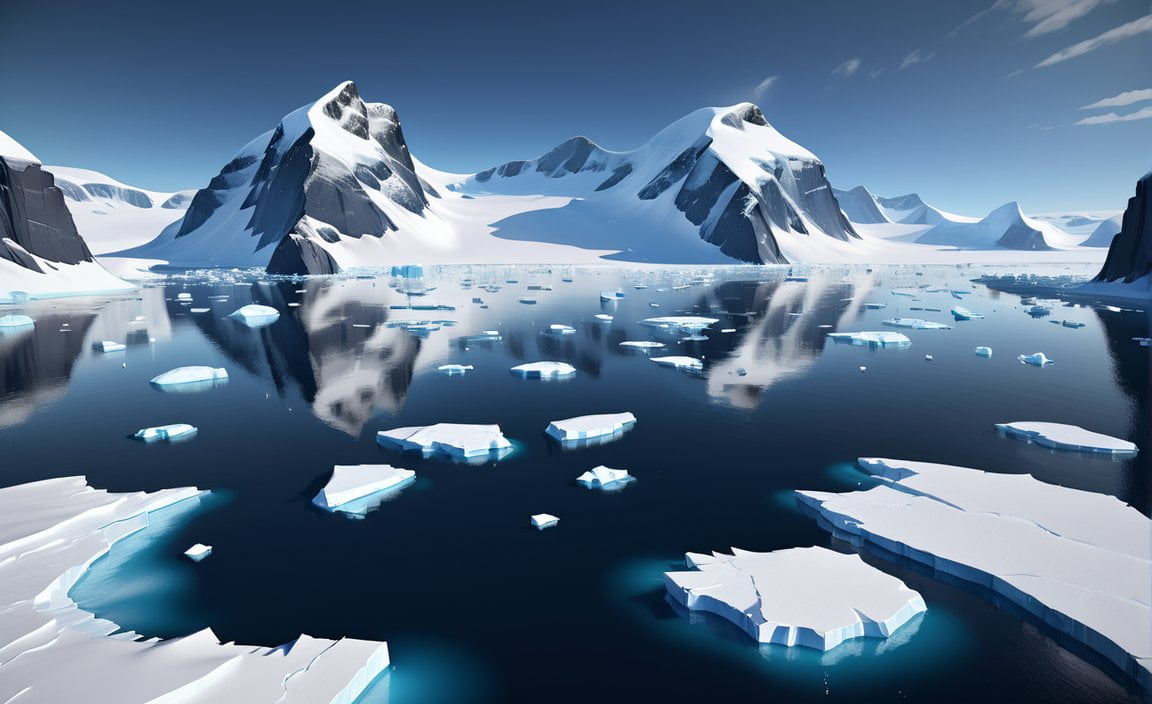
FAQ
Q1: What is the coldest continent on Earth?
A1: Antarctica is the coldest continent on Earth, with the lowest recorded temperature reaching -89.2 degrees Celsius.
Q2: How much of the world’s ice does Antarctica contain?
A2: Antarctica contains about 90% of the world’s ice and about 70% of the world’s fresh water.
Q3: How large is Antarctica compared to other continents?
A3: Antarctica is the fifth-largest continent and is double the size of Australia.
Q4: Does Antarctica have any permanent human residents?
A4: Antarctica has no permanent human residents, but it does host several research stations with scientists and support staff.
Q5: What kind of wildlife can be found in Antarctica?
A5: Antarctica is home to a variety of wildlife, including penguins, seals, whales, albatrosses, and krill.
- Discover Long Black Pepper: Flavor & Health Benefits - April 25, 2025
- Shocking Twists: The Grownup Review: Unreliable Narration - April 25, 2025
- A Quiet Place Book vs Movie: A Deep Dive - April 25, 2025
